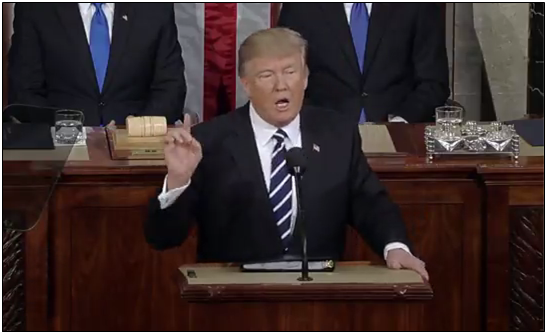“President Trump’s budget is based on a sober assessment of economic growth and achieves balance not through Washingtonian gimmickry but through $4.5 trillion of real cuts to baseline spending over 10 years.”
That was Americans for Limited Government President Rick Manning’s reaction to the first full budget proposed by President Donald Trump that, remarkably, considering the document was authored in Washington, D.C., achieves balance in 10 years with real spending cuts to the baseline.
Even more startling, the budget uses revenue-neutral assumptions to get where it gets in terms of being balanced. For example, it might have been very tempting for the Trump budget team to incorporate its tax cut plan, for example, and assume a big jump in economic growth, labor participation and thus tax revenues to get to its 10-year balanced budget.
Instead, the tax plan is left out. Revenues are roughly the same, minus $1 trillion to do with repealing taxes related to Obamacare. So, revenues will actually be less than under current law, at $45.7 trillion over 10 years instead of $46.7 trillion.
Here, Trump arguably does the harder thing by proposing real cuts for Congress to consider. So, instead of spending $53.4 trillion over 10 years as under current law, President Trump proposes that Congress only spend $48.9 trillion — totaling $4.5 trillion of spending cuts.
The spending reductions include $1.8 trillion of cuts to non-defense department and agency spending, $1.25 trillion of cuts to do with repealing Obamacare and an additional $627 billion of cuts to do with the sun setting of Medicaid expansion.
There is also $1 trillion of other cuts over 10 years to other so-called mandatory spending programs including grants across every department: $143 billion of cuts at the Department of Education, $46 billion at the Department of Agriculture, $29.6 billion from the Department of Energy, $16.8 billion from the Department of Homeland Security, $5.7 billion from the Department of Interior, $21.6 billion from the Department of Labor, $49.6 billion from the Department of Transportation, $15.2 billion from the Department of Veterans Affairs, $46 billion from the Postal Service, $62.9 billion from the Office of Personnel Management, $190 billion from the Supplemental Nutrition Assistance Program, eliminating $142.2 billion of improper payments across the government, cutting $55 billion by reforming the medical liability system and cutting $35 billion from government financial bailout funds.
Finally, because of all the cuts, taxpayers will save $323 billion from interest payments over 10 years.
Since when do administrations propose anything besides increasing spending?
Some will quibble about the use the 10-year projections, and on discretionary agency spending, the point is well taken—spending there is subject to annual appropriations—but on the so-called mandatory side the ledger, for example, repealing Obamacare this year will have impact that will reverberate into subsequent budget years. Increasing federal employee retirement contributions has out-year effects, and so forth.
As far as economic growth goes, the White House Office of Management and Budget (OMB) does not see that returning to 3 percent — for the first time since 2005 — until 2021. That’s an honest assessment that takes into account the weakest decade of growth in U.S. history from 2007 to 2016, even weaker than 1930 to 1939 in the Great Depression.
Those economic assumptions are a refreshing departure from the Obama administration, which relied on pie in the sky economic growth forecasts in its budgets following the financial crisis. The Obama budget team predicted 3 percent growth by 2010, 4 percent by 2011 and 4.6 percent by 2012, but that robust recovery never happened. Instead growth averaged just 1.5 percent a year under Obama.
To be fair, on the other hand, OMB like in past years foresees no recessions, no upticks in unemployment. But if you just take the projections as a 10-year average of 2.83 percent growth a year, that would still be less than the 1945 to 2007 postwar average of 3.1 percent when we averaged a recession every six to seven years. As usual, if we do have another recession, it will require a commensurate robust recovery to balance out.
Certainly, one hopes robust growth is restored under Trump. To that end, Manning said implementing the Trump economic program could provide immediate relief: “when the President’s tax, regulatory and trade reforms take effect, the economic growth that they create should be a windfall for the U.S. economy — as more discouraged workers enter the labor force after a decade-long losing streak, and real wages finally increase.”
The Trump budget also makes no assumptions about millions of individuals returning to the labor force. We know that because there is no change in payroll tax revenue between the baseline scenario and the proposed budget scenario. If OMB thought more individuals would be entering the labor force, then we’d see an increase in payroll tax revenue. Instead, the Trump budget team went OMB’s baseline assumptions, which foresee $11.2 trillion of Social Security payroll taxes over the next 10 years.
Whether those forecasts assuming levels of employment are rosy in their own right is a separate matter, but nobody can accuse the Trump administration of padding its numbers.
Which, is how a conservative budget ought to be drafted, Americans for Limited Government’s Manning contended, concluding, “the President takes nothing for granted, and should find willing allies amongst the Congressional GOP as their once in a generation opportunity to achieve an historic agreement on rational spending priorities moves forward.”
Usually budgets proposed by presidents are dead on arrival in Congress, and for good reason, they usually spend far more than we as a nation can afford. But for the first time in a generation, President Trump has offered a budget that gets to balance, not through gimmicks, but through $4.5 trillion of real spending cuts. Congress needs to use this budget as a roadmap.
Robert Romano is the senior editor of Americans for Limited Government.







